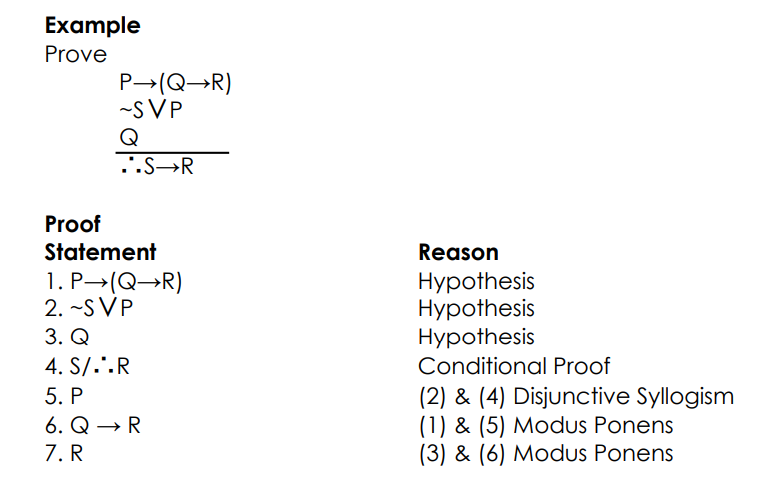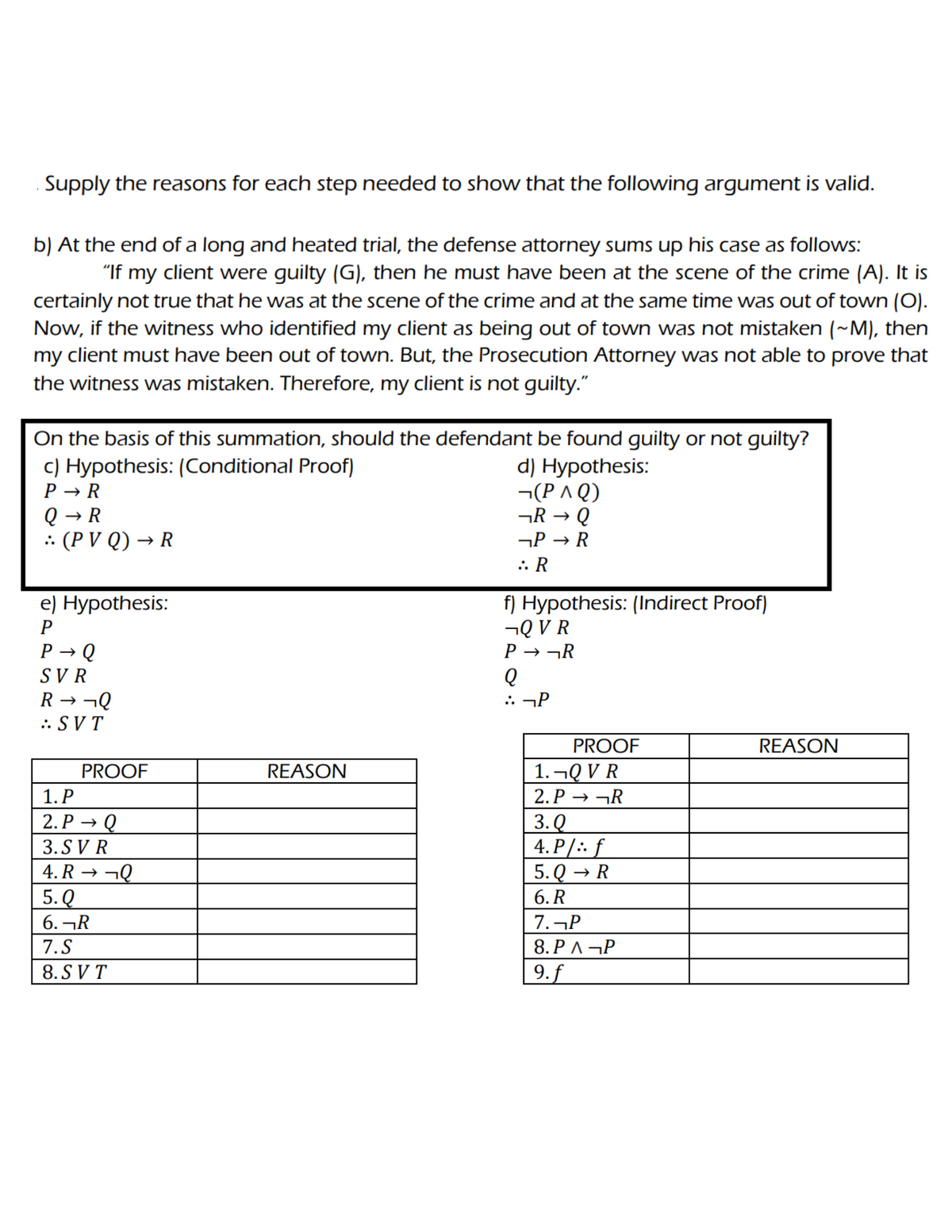On the basis of this summation, should the defendant be found guilty or not guilty? c) Hypothesis: (Conditional Proof) d) Hypothesis: P→ R Q→ → R :. (PVQ) R ¬(PAQ) ¬R → Q P→ R :. R
On the basis of this summation, should the defendant be found guilty or not guilty? c) Hypothesis: (Conditional Proof) d) Hypothesis: P→ R Q→ → R :. (PVQ) R ¬(PAQ) ¬R → Q P→ R :. R
Advanced Engineering Mathematics
10th Edition
ISBN:9780470458365
Author:Erwin Kreyszig
Publisher:Erwin Kreyszig
Chapter2: Second-order Linear Odes
Section: Chapter Questions
Problem 1RQ
Related questions
Question
answer the c and d based on the guven example

Transcribed Image Text:Example
Prove
P→(Q→R)
-SVP
Q
...S→R
Proof
Statement
1. P→(Q→R)
2. -SVP
3. Q
4. S/..R
5. P
6. Q→ R
7. R
Reason
Hypothesis
Hypothesis
Hypothesis
Conditional Proof
(2) & (4) Disjunctive Syllogism
(1) & (5) Modus Ponens
(3) & (6) Modus Ponens

Transcribed Image Text:Supply the reasons for each step needed to show that the following argument is valid.
b) At the end of a long and heated trial, the defense attorney sums up his case as follows:
"If my client were guilty (G), then he must have been at the scene of the crime (A). It is
certainly not true that he was at the scene of the crime and at the same time was out of town (O).
Now, if the witness who identified my client as being out of town was not mistaken (~M), then
my client must have been out of town. But, the Prosecution Attorney was not able to prove that
the witness was mistaken. Therefore, my client is not guilty."
On the basis of this summation, should the defendant be found guilty or not guilty?
c) Hypothesis: (Conditional Proof)
d) Hypothesis:
P R
Q
:. (PV Q) → R
→ R
e) Hypothesis:
P
P→ Q
SVR
R→ ¬Q
: SVT
PROOF
1. P
2. P→ Q
3. SVR
4. R→ ¬Q
5.Q
6.¬R
7.S
8. SVT
REASON
¬(P^Q)
¬R → Q
P→ R
:R
f) Hypothesis: (Indirect Proof)
¬QVR
P→ ¬R
Q
: ¬P
PROOF
1. ¬Q VR
2.P→ ¬R
3. Q
4.P/: f
R
5.Q
6. R
7. ¬P
8. PAP
9.f
REASON
Expert Solution
This question has been solved!
Explore an expertly crafted, step-by-step solution for a thorough understanding of key concepts.
Step by step
Solved in 4 steps

Recommended textbooks for you

Advanced Engineering Mathematics
Advanced Math
ISBN:
9780470458365
Author:
Erwin Kreyszig
Publisher:
Wiley, John & Sons, Incorporated

Numerical Methods for Engineers
Advanced Math
ISBN:
9780073397924
Author:
Steven C. Chapra Dr., Raymond P. Canale
Publisher:
McGraw-Hill Education

Introductory Mathematics for Engineering Applicat…
Advanced Math
ISBN:
9781118141809
Author:
Nathan Klingbeil
Publisher:
WILEY

Advanced Engineering Mathematics
Advanced Math
ISBN:
9780470458365
Author:
Erwin Kreyszig
Publisher:
Wiley, John & Sons, Incorporated

Numerical Methods for Engineers
Advanced Math
ISBN:
9780073397924
Author:
Steven C. Chapra Dr., Raymond P. Canale
Publisher:
McGraw-Hill Education

Introductory Mathematics for Engineering Applicat…
Advanced Math
ISBN:
9781118141809
Author:
Nathan Klingbeil
Publisher:
WILEY

Mathematics For Machine Technology
Advanced Math
ISBN:
9781337798310
Author:
Peterson, John.
Publisher:
Cengage Learning,

